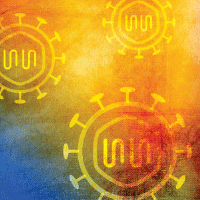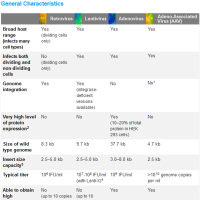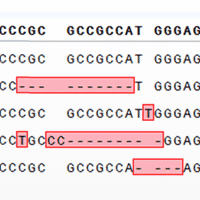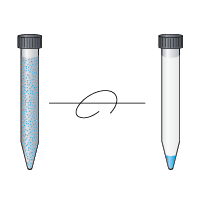635002
pRetro-Lib Vector
20 ug
USD $375.00
pRetro-Lib, derived from Moloney murine leukemia virus (MoMuLV), is designed for delivery and expression of retroviral libraries or genes. Upon transfection into a packaging cell line, pRetro-Lib can transiently express, or integrate and stably express, a transcript containing (psi, the extended viral packaging signal) and the gene of interest. The 5' viral LTR in this vector contains a viral promoter that controls expression of genes cloned into the MCS.
Notice to purchaser
Our products are to be used for Research Use Only . They may not be used for any other purpose, including, but not limited to, use in humans, therapeutic or diagnostic use, or commercial use of any kind. Our products may not be transferred to third parties, resold, modified for resale, or used to manufacture commercial products or to provide a service to third parties without our prior written approval.
631516
Retro-X™ Q Vector Set
4 x 20 ug
USD $625.00
The Retro-X Q Vector set provides four retroviral expression vectors that are optimized to eliminate promoter interference from the upstream LTR in the integrated provirus. Each vector expresses a target gene along with a different selection marker from a single, bicistronic message. The CMV promoter present in the 5' LTR produces high viral titers in standard packaging cell lines. A LacZ Control Vector pQCLIN is included in the set. Also included are Retro-X Q Primers that encode sequences flanking the multiple cloning site.
Notice to purchaser
Our products are to be used for Research Use Only . They may not be used for any other purpose, including, but not limited to, use in humans, therapeutic or diagnostic use, or commercial use of any kind. Our products may not be transferred to third parties, resold, modified for resale, or used to manufacture commercial products or to provide a service to third parties without our prior written approval.
631515
pQCXIX Retroviral Vector
20 ug
USD $456.00
The pQCXIX Retroviral Vector is a self-inactivating retroviral expression vector that is optimized to eliminate promoter interference from the upstream LTR in the integrated provirus. It expresses two target genes from a single, bicistronic message. The CMV promoter present in the 5' LTR produces high viral titers in standard packaging cell lines. A deletion in the 3' LTR provides the self-inactivating feature after reverse transcription of the expression cassette. This vector is useful for applications in which high titers and high-level bicistronic gene expression are desired.
Notice to purchaser
Our products are to be used for Research Use Only . They may not be used for any other purpose, including, but not limited to, use in humans, therapeutic or diagnostic use, or commercial use of any kind. Our products may not be transferred to third parties, resold, modified for resale, or used to manufacture commercial products or to provide a service to third parties without our prior written approval.
631514
pQCXIN Retroviral Vector
20 ug
USD $456.00
The pQCXIN Retroviral Vector is a self-inactivating retroviral Q expression vector that is optimized to eliminate promoter interference from the upstream LTR in the integrated provirus. It expresses a target gene along with the gene for the neomycin resistance marker from a single, bicistronic message. The CMV promoter present in the 5' LTR produces high viral titers in standard packaging cell lines. A deletion in the 3' LTR provides the self-inactivating feature after reverse transcription of the expression cassette. This vector is useful for applications in which high titers and high-level gene expression are desired.
Notice to purchaser
Our products are to be used for Research Use Only . They may not be used for any other purpose, including, but not limited to, use in humans, therapeutic or diagnostic use, or commercial use of any kind. Our products may not be transferred to third parties, resold, modified for resale, or used to manufacture commercial products or to provide a service to third parties without our prior written approval.
631511
LRCX Retroviral Vector Set
Each
USD $575.00
A system composed of three retroviral cloning vectors, as well as 5' and 3' LNCX sequencing/PCR primers. The system is suitable for use with the Retro-X system (Cat No. 631508). The pLNCX2, pLPCX, and pLHCX retroviral vectors contain a gene encoding resistance to neomycin, puromycin, or hygromycin, respectively. With these vectors, a gene of interest is expressed under control of the CMV promoter. The vectors are excellent tools for expression studies in primary cell lines, explants, or whole animals.
Notice to purchaser
Our products are to be used for Research Use Only . They may not be used for any other purpose, including, but not limited to, use in humans, therapeutic or diagnostic use, or commercial use of any kind. Our products may not be transferred to third parties, resold, modified for resale, or used to manufacture commercial products or to provide a service to third parties without our prior written approval.
631509
pLXSN Retroviral Vector
20 ug
USD $440.00
pLXSN is designed for retroviral gene delivery and expression of gene of interest. It contains the retroviral packaging sequence (Ψ+) and so, when transfected into a cell line expressing the retroviral structural proteins (gag, pol, and env ), leads to packaging of viral particles. The 5' viral LTR in this vector contains a viral promoter that controls expression of the gene of interest.
Notice to purchaser
Our products are to be used for Research Use Only . They may not be used for any other purpose, including, but not limited to, use in humans, therapeutic or diagnostic use, or commercial use of any kind. Our products may not be transferred to third parties, resold, modified for resale, or used to manufacture commercial products or to provide a service to third parties without our prior written approval.
631503
pLNCX2 Retroviral Vector
20 ug
USD $440.00
pLNCX2 is designed for retroviral gene delivery and expression. Upon transfection into a packaging cell line, pLNCX2 can transiently express, or integrate and stably express, a transcript containing the Ψ viral packaging signal, a selectable marker, and the geneof interest, which is cloned into the MCS under the control of the immediate early promoter of human cytomegalovirus (P CMV ). The 5' viral LTR drives expression of the neomycin resistance gene for antibiotic selection in eukaryotic cells.
Notice to purchaser
Our products are to be used for Research Use Only . They may not be used for any other purpose, including, but not limited to, use in humans, therapeutic or diagnostic use, or commercial use of any kind. Our products may not be transferred to third parties, resold, modified for resale, or used to manufacture commercial products or to provide a service to third parties without our prior written approval.
631501
pLXIN Retroviral Vector
20 ug
USD $440.00
pLXIN is a bicistronic retroviral vector containing an internal ribosome entry site (IRES). The 5' LTR thus regulates expression of a gene of interest and the neomycin resistance gene on the same bicistronic message.
Notice to purchaser
Our products are to be used for Research Use Only . They may not be used for any other purpose, including, but not limited to, use in humans, therapeutic or diagnostic use, or commercial use of any kind. Our products may not be transferred to third parties, resold, modified for resale, or used to manufacture commercial products or to provide a service to third parties without our prior written approval.
3658
pDON-5 DNA
20 ug
USD $446.00
This product is a plasmid vector for producing a high expression efficiency retrovirus vector. By transfecting this vector into an appropriate packaging cell line, the vector transiently or stably expresses transcribed products containing the virus-packaging signal (Ψ) and target gene. This vector possesses LTR and Ψ (viral packaging signal), but not the structural genes necessary for particle formation and replication (sequences gag , pol , and env ). Because this vector contains an intron with high splicing capacity, it yields high transcription efficiency. This vector contains the HCMV IE promoter (which can produce high-titer retroviruses) within the U3 region of the 5' LTR, and a neomycin resistant gene as a selective marker.
Notice to purchaser
Our products are to be used for Research Use Only . They may not be used for any other purpose, including, but not limited to, use in humans, therapeutic or diagnostic use, or commercial use of any kind. Our products may not be transferred to third parties, resold, modified for resale, or used to manufacture commercial products or to provide a service to third parties without our prior written approval.
3657
pDON-5 Neo DNA
20 ug
USD $446.00
This product is a plasmid vector for producing a high expression efficiency retrovirus vector. By transfecting this vector into an appropriate packaging cell line, the vector transiently or stably expresses transcribed products containing the virus-packaging signal (Ψ), target gene and selective marker. This vector possesses LTR and Ψ (viral packaging signal), but not the structural genes necessary for particle formation and replication (sequences gag , pol , and env ). Because this vector contains an intron with high splicing capacity, it yields high transcription efficiency. This vector contains the HCMV IE promoter (which can produce high-titer retroviruses) within the U3 region of the 5' LTR, and a neomycin resistant gene as a selective marker.
Notice to purchaser
Our products are to be used for Research Use Only . They may not be used for any other purpose, including, but not limited to, use in humans, therapeutic or diagnostic use, or commercial use of any kind. Our products may not be transferred to third parties, resold, modified for resale, or used to manufacture commercial products or to provide a service to third parties without our prior written approval.
3656
pMEI-5 DNA
20 ug
USD $446.00
This product is a plasmid vector for producing a high expression efficiency retrovirus vector. By transfecting this vector into an appropriate packaging cell line, the vector transiently or stably expresses transcribed products containing the virus-packaging signal (Ψ), target gene and selective marker. This vector possesses LTR and Ψ (viral packaging signal), but not the structural genes necessary for particle formation and replication (sequences gag , pol , and env ). Because this vector contains an intron with high splicing capacity, it yields high transcription efficiency. Gene expression two to eight-fold higher than pDON-Al-2 series can be expected.
Notice to purchaser
Our products are to be used for Research Use Only . They may not be used for any other purpose, including, but not limited to, use in humans, therapeutic or diagnostic use, or commercial use of any kind. Our products may not be transferred to third parties, resold, modified for resale, or used to manufacture commercial products or to provide a service to third parties without our prior written approval.
3655
pMEI-5 Neo DNA
20 ug
USD $446.00
This product is a plasmid vector for producing a high expression efficiency retrovirus vector. By transfecting this vector into an appropriate packaging cell line, the vector transiently or stably expresses transcribed products containing the virus-packaging signal (Ψ), target gene and selective marker. This vector possesses LTR and Ψ (viral packaging signal), but not the structural genes necessary for particle formation and replication (sequences gag , pol , and env ). Because this vector contains an intron with high splicing capacity, it yields high transcription efficiency. pMEI-5 Neo DNA (Cat.# 3655) contains the neomycin resistance gene as a selective marker. Gene expression two to eight-fold higher than pDON-Al-2 series can be expected.
Notice to purchaser
Our products are to be used for Research Use Only . They may not be used for any other purpose, including, but not limited to, use in humans, therapeutic or diagnostic use, or commercial use of any kind. Our products may not be transferred to third parties, resold, modified for resale, or used to manufacture commercial products or to provide a service to third parties without our prior written approval.
3654
pDON-AI-2 DNA
20 ug
USD $446.00
pDON-AI-2 DNA enables production of a retrovirus vector with high transfer efficiency. By transfecting the vector into an appropriate packaging cell line, the vector expresses transient or stable transcribed product containing virus-packaging signal (Ψ) and target gene. This vector possesses LTR and Ψ (viral packaging signal), but not the structural gene necessary for particle formation and replication, which are gag , pol , and env , and contains HCMV IE promoter within the U3 region of 5'LTR. The production of 2–8-fold higher-titer virus can be achieved by transfecting a version of pDON-AI-2 DNA containing a target gene compared using conventional retrovirus vector.
Notice to purchaser
Our products are to be used for Research Use Only . They may not be used for any other purpose, including, but not limited to, use in humans, therapeutic or diagnostic use, or commercial use of any kind. Our products may not be transferred to third parties, resold, modified for resale, or used to manufacture commercial products or to provide a service to third parties without our prior written approval.
3653
pDON-AI-2 Neo DNA
20 ug
USD $446.00
pDON-AI-2 DNA enables production of a retrovirus vector with high transfer efficiency. By transfecting the vector into an appropriate packaging cell line, the vector expresses transient or stable transcribed product containing virus-packaging signal (Ψ) and target gene. This vector possesses LTR and Ψ (viral packaging signal), but not the structural gene necessary for particle formation and replication, which are gag , pol , and env , and contains HCMV IE promoter within the U3 region of 5'LTR. pDON-AI-2 Neo DNA contains a neomycin resistant gene as a selective marker. The production of 2–8-fold higher-titer virus can be achieved by transfecting a version of pDON-AI-2 DNA containing a target gene compared using conventional retrovirus vector.
Notice to purchaser
Our products are to be used for Research Use Only . They may not be used for any other purpose, including, but not limited to, use in humans, therapeutic or diagnostic use, or commercial use of any kind. Our products may not be transferred to third parties, resold, modified for resale, or used to manufacture commercial products or to provide a service to third parties without our prior written approval.







